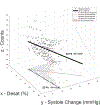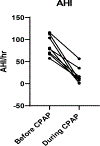Elucidation of obstructive sleep apnoea related blood pressure surge using a novel continuous beat-to-beat blood pressure monitoring system
- PMID: 34751170
- PMCID: PMC8810587
- DOI: 10.1097/HJH.0000000000003041
Elucidation of obstructive sleep apnoea related blood pressure surge using a novel continuous beat-to-beat blood pressure monitoring system
Abstract
Background: Obstructive sleep apnoea (OSA) episode related blood pressure (BP) surge may mediate the association of OSA with cardiovascular disease. However, BP is not measured during a clinical sleep study.
Method: We tested the feasibility of incorporating the Caretaker physiological monitor, which utilizes a novel continuous beat-to-beat (b-b) BP monitoring technology, into polysomnography (PSG) and aimed to characterize BP surges related to obstructive respiratory events. B-b BP was concurrently collected and merged with PSG data on a posthoc basis. We compared BP surge between mean respiratory (apnoea, hypopnea and desaturation-alone events) and nonrespiratory events (spontaneous or leg movement-related arousals). We examined the association of the degree of oxygen desaturation with BP surge in a given respiratory event combining all events. A total of 17 consecutive patients (12 men, mean 52 years old, nine diagnostic and eight split-night PSGs) undergoing clinically indicated PSG were included after excluding one patient with poor signal quality due to excessive movement.
Results: Caretaker was well tolerated. Mean respiratory BP surge ranged from 5 to 19 mmHg [Median (IQR) = 13.9 (9.5--16.2)]. Mean BP surge between the respiratory and nonrespiratory events was similar [13.8 (4.5) vs. 14.9 (5.3) mmHg, P = 0.13]. Accounting for the count distribution of desaturation/BP surge data pair events, there was a linear correlation between the degree of oxygen desaturation and BP surge (R = 0.57, P < 0.001). In eight patients undergoing split-night sleep studies, the number of BP surge events (≥10 mmHg/h) decreased during continuous positive airway pressure in all but one patient.
Conclusion: We demonstrated highly variable OSA-related BP surge patterns using the Caretaker's b-b BP monitoring technology that has the potential to be integrated into sleep studies.
Copyright © 2021 Wolters Kluwer Health, Inc. All rights reserved.
Conflict of interest statement
Figures






References
-
- Somers VK, White DP, Amin R, Abraham WT, Costa F, Culebras A, et al. Sleep apnea and cardiovascular disease: an American Heart Association/american College Of Cardiology Foundation Scientific Statement from the American Heart Association Council for High Blood Pressure Research Professional Education Committee, Council on Clinical Cardiology, Stroke Council, and Council On Cardiovascular Nursing. In collaboration with the National Heart, Lung, and Blood Institute National Center on Sleep Disorders Research (National Institutes of Health). Circulation. 2008. Sep 2;118(10):1080–111. - PubMed
Publication types
MeSH terms
Grants and funding
LinkOut - more resources
Full Text Sources

